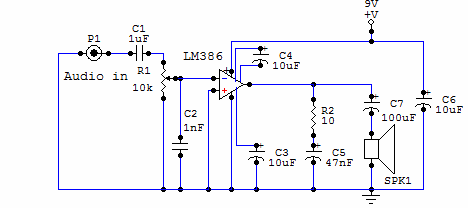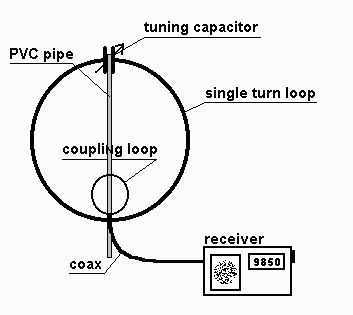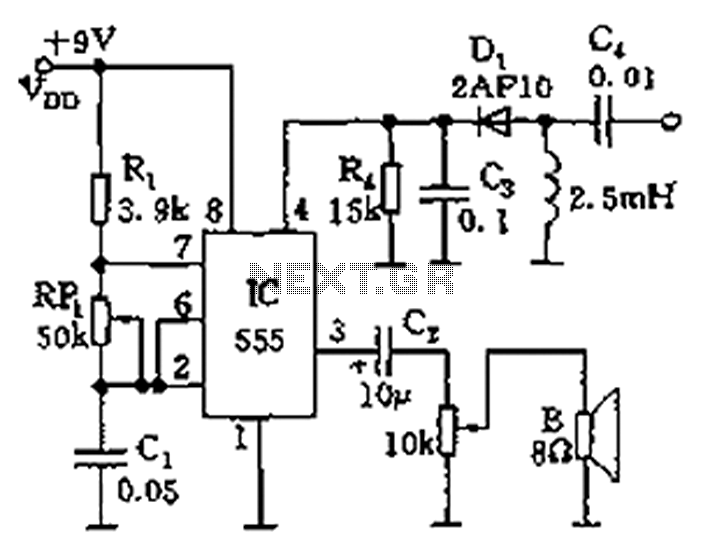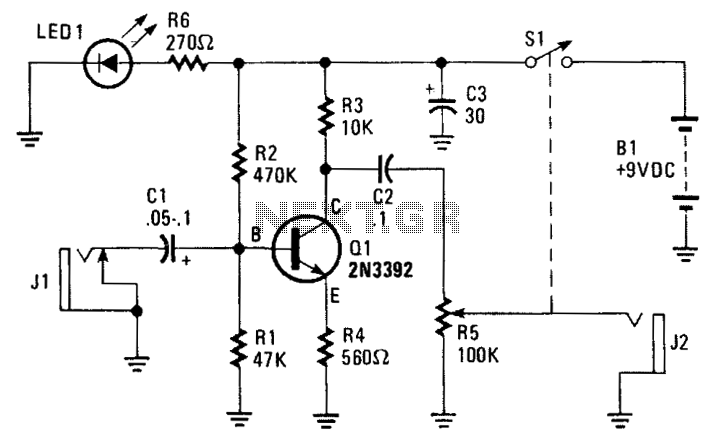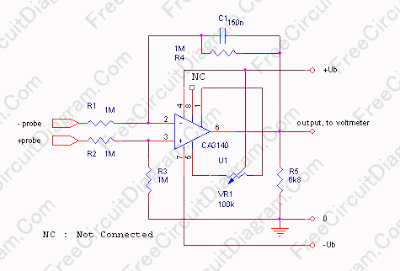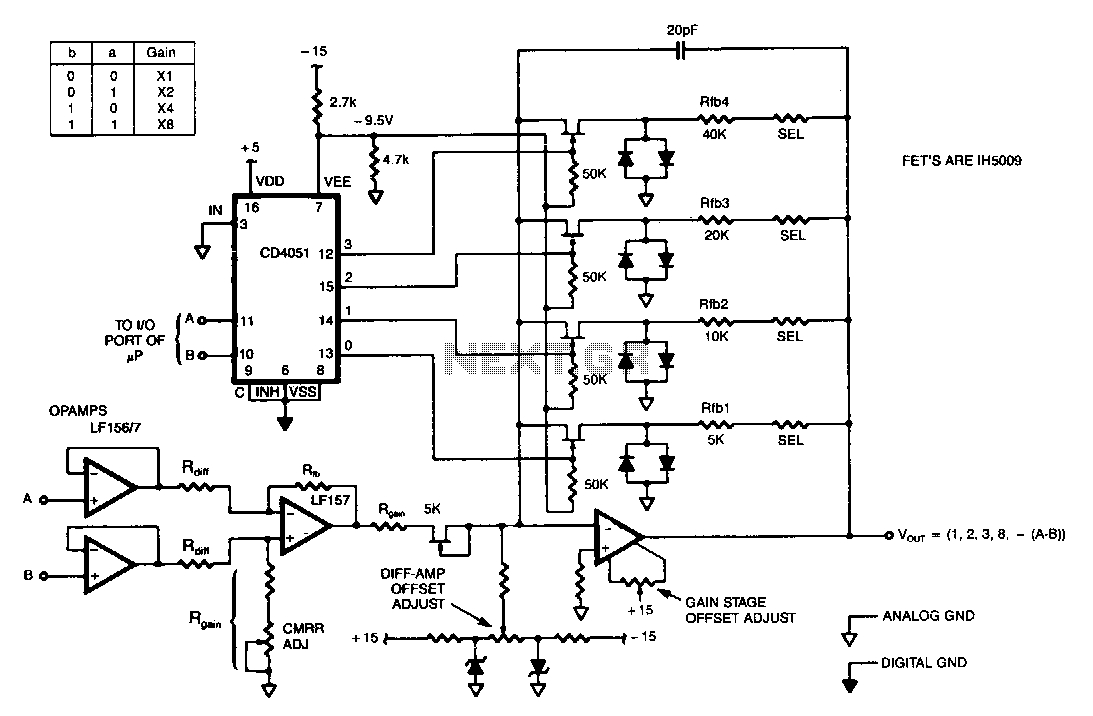
Antenna Input & Audio Lineout Adaptor For Portable Radios
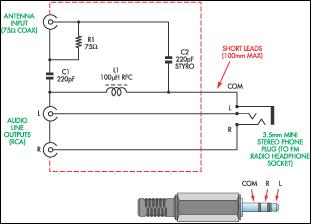
This document presents a concept for a low-cost adapter that enables the connection of a portable FM radio or MP3 player with an FM tuner to an external antenna and audio equipment, such as a hi-fi system or PC sound card. Portable FM radios and some MP3 players typically feature a 3.5mm stereo jack socket for headphone connections, where the shield conductor of the headphone cable also functions as an antenna. Recently, a budget FM radio with a USB connector was acquired, intended for use with a PC. The package included an audio cable with 3.5mm stereo phone plugs on both ends. The plug that connects to the radio has an additional wire (approximately 2 meters long) designed to act as an indoor antenna. However, using the supplied cable resulted in poor radio reception and audio quality. The reception issues were attributed to the radio's operation in a marginal TV/FM reception area. Upon testing the cable, it was discovered that there was no audio ground connection, as the cable shield was unconnected at the radio end. The antenna wire in these devices connects to the "common" terminal of the 3.5mm socket, which typically serves as the audio signal return path. Connecting this terminal to the ground of external audio equipment would compromise the antenna signal. The designer of this cable likely assumed that an adequate audio ground connection would be established indirectly via the USB cable, which was a flawed assumption. The challenge was to create a reliable antenna signal for the radio while establishing a solid audio ground connection to external equipment, preferably without relying on the USB connector and without modifying the radio’s internal components. The accompanying circuit diagram illustrates a solution to this challenge. The radio-frequency choke (L1) has low impedance at audio frequencies, facilitating an audio ground path to the line output sockets from the radio's antenna input ("common" terminal). Conversely, the RFC presents high impedance to the RF antenna signal, preventing it from being shorted to ground. The antenna signal is coupled to the radio through two 220pF polystyrene or ceramic capacitors, which also block low-frequency interference, such as mains hum. It is noteworthy that the design depends on the capacitance in the audio cable to couple the antenna ground (cable shield) to the radio's internal ground. To construct the adapter, the components should be mounted in a small plastic enclosure and wired according to the provided schematic. A suitable choke can be sourced from Jaycar (Cat. No. LF-1534). The leads connecting to the 3.5mm plug should not exceed approximately 100mm in length and do not require shielding. With an appropriate TV/FM antenna, the unit demonstrated impressive performance, even in areas with poor FM reception, achieving good audio frequency response and signal-to-noise ratio, especially given the low cost of the radio (approximately $40).
The proposed adapter circuit effectively addresses the common challenges faced when connecting portable FM radios or MP3 players to external audio systems and antennas. By utilizing a radio-frequency choke, the circuit design ensures that audio signals are properly grounded while maintaining a clear path for the antenna signal. The use of capacitors to block low-frequency noise further enhances the overall performance, making this adapter a practical solution for users experiencing interference and audio quality issues. The compact design and straightforward assembly process make it accessible for hobbyists and engineers alike, providing a cost-effective means to improve the functionality of portable FM radios in various environments. This approach highlights the importance of careful consideration of grounding and signal paths in audio and radio frequency applications, ensuring optimal performance in real-world scenarios.Here is an idea for a simple low-cost adaptor that allows a portable FM radio (or MP3 player with FM tuner) to be connected to an external antenna and to audio equipment such as a hifi system or PC sound card. Portable FM radios and some MP3 players typically provide a 3. 5mm stereo jack socket for the headphone connection, with the shield conducto r of the headphone cable doubling as an antenna. Recently, the author bought a cheap FM radio with a USB connector, designed to be operated with a PC. The package included an audio cable with a 3. 5mm stereo phone plug at each end. The plug that goes into the radio has an additional wire (about 2m long) hanging out of it, which is meant to serve as an indoor antenna.
When using the supplied cable, the system suffered from poor radio reception (too much interference), and poor audio quality (lack of bass). The first problem was easily explained, as the radio was used in a marginal TV/FM reception area. When the cable was "buzzed out", the reason for the second problem became apparent. There was no audio ground connection, as the cable screen is not connected to anything at the radio end!
As mentioned, the antenna wire in these units is connected to the "common" terminal of the 3. 5mm socket, which normally doubles as the audio signal return path. If this terminal were to be connected to the ground of external audio equipment, the antenna signal would be clobbered. Perhaps the designer of this cable assumed that an adequate audio ground connection would be made indirectly via the USB cable a poor assumption!
The challenge then was to provide a good antenna signal for the radio while at the same time making a good audio ground connection to external equipment. Preferably, this was to be achieved without relying on the USB connector (because not all FM radios have one) and without having to mess with the radio`s internal works.
The accompanying circuit diagram shows how this can be achieved. The radio-frequency choke (L1) has a low impedance at audio frequencies, thereby making an audio ground path to the line output sockets from the radio`s antenna input ("common" terminal). Conversely, the RFC presents a high impedance to the RF antenna signal, so preventing it from being shorted to ground.
The antenna signal is coupled to the radio via two 220pF polystyrene (or ceramic) capacitors, which also block low-frequency interference (eg, mains hum). Note that the design relies on the capacitance in the audio cable to couple the antenna "ground" (cable shield) to the radio`s internal "ground".
To build the adaptor, simply mount the parts in a small plastic box and wire up as shown. A suitable choke is available from Jaycar (Cat. No. LF-1534). The leads going to the 3. 5mm plug should be no longer than about 100mm and need not be shielded. With a good TV/FM antenna, the author`s unit performed remarkably well, even in a poor FM reception area. The audio frequency response and signal-to-noise ratio were surprisingly good considering the low cost of the radio (about $40).
🔗 External reference
The proposed adapter circuit effectively addresses the common challenges faced when connecting portable FM radios or MP3 players to external audio systems and antennas. By utilizing a radio-frequency choke, the circuit design ensures that audio signals are properly grounded while maintaining a clear path for the antenna signal. The use of capacitors to block low-frequency noise further enhances the overall performance, making this adapter a practical solution for users experiencing interference and audio quality issues. The compact design and straightforward assembly process make it accessible for hobbyists and engineers alike, providing a cost-effective means to improve the functionality of portable FM radios in various environments. This approach highlights the importance of careful consideration of grounding and signal paths in audio and radio frequency applications, ensuring optimal performance in real-world scenarios.Here is an idea for a simple low-cost adaptor that allows a portable FM radio (or MP3 player with FM tuner) to be connected to an external antenna and to audio equipment such as a hifi system or PC sound card. Portable FM radios and some MP3 players typically provide a 3. 5mm stereo jack socket for the headphone connection, with the shield conducto r of the headphone cable doubling as an antenna. Recently, the author bought a cheap FM radio with a USB connector, designed to be operated with a PC. The package included an audio cable with a 3. 5mm stereo phone plug at each end. The plug that goes into the radio has an additional wire (about 2m long) hanging out of it, which is meant to serve as an indoor antenna.
When using the supplied cable, the system suffered from poor radio reception (too much interference), and poor audio quality (lack of bass). The first problem was easily explained, as the radio was used in a marginal TV/FM reception area. When the cable was "buzzed out", the reason for the second problem became apparent. There was no audio ground connection, as the cable screen is not connected to anything at the radio end!
As mentioned, the antenna wire in these units is connected to the "common" terminal of the 3. 5mm socket, which normally doubles as the audio signal return path. If this terminal were to be connected to the ground of external audio equipment, the antenna signal would be clobbered. Perhaps the designer of this cable assumed that an adequate audio ground connection would be made indirectly via the USB cable a poor assumption!
The challenge then was to provide a good antenna signal for the radio while at the same time making a good audio ground connection to external equipment. Preferably, this was to be achieved without relying on the USB connector (because not all FM radios have one) and without having to mess with the radio`s internal works.
The accompanying circuit diagram shows how this can be achieved. The radio-frequency choke (L1) has a low impedance at audio frequencies, thereby making an audio ground path to the line output sockets from the radio`s antenna input ("common" terminal). Conversely, the RFC presents a high impedance to the RF antenna signal, so preventing it from being shorted to ground.
The antenna signal is coupled to the radio via two 220pF polystyrene (or ceramic) capacitors, which also block low-frequency interference (eg, mains hum). Note that the design relies on the capacitance in the audio cable to couple the antenna "ground" (cable shield) to the radio`s internal "ground".
To build the adaptor, simply mount the parts in a small plastic box and wire up as shown. A suitable choke is available from Jaycar (Cat. No. LF-1534). The leads going to the 3. 5mm plug should be no longer than about 100mm and need not be shielded. With a good TV/FM antenna, the author`s unit performed remarkably well, even in a poor FM reception area. The audio frequency response and signal-to-noise ratio were surprisingly good considering the low cost of the radio (about $40).
🔗 External reference
Warning: include(partials/cookie-banner.php): Failed to open stream: Permission denied in /var/www/html/nextgr/view-circuit.php on line 713
Warning: include(): Failed opening 'partials/cookie-banner.php' for inclusion (include_path='.:/usr/share/php') in /var/www/html/nextgr/view-circuit.php on line 713
